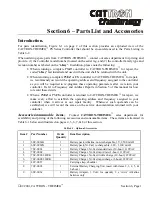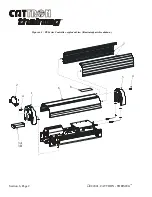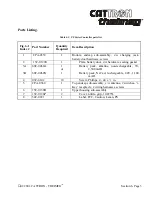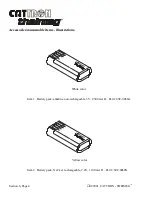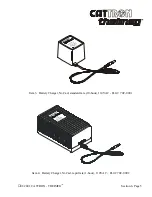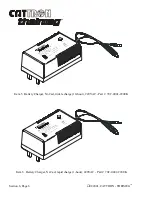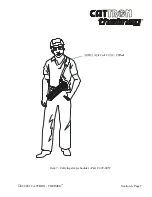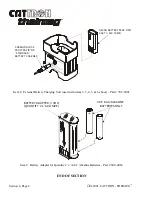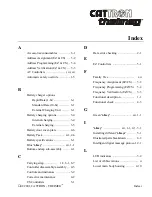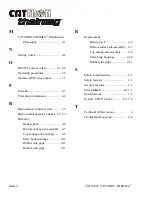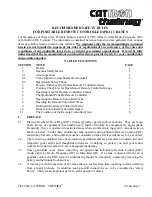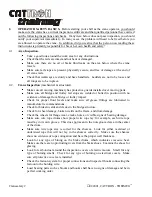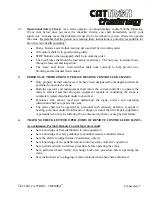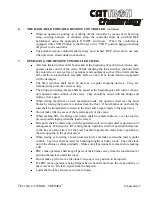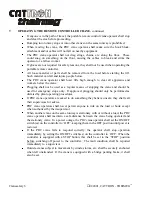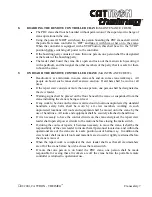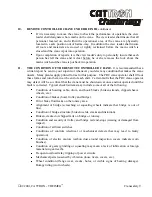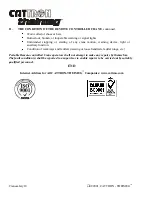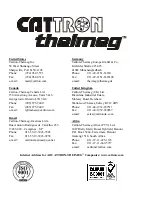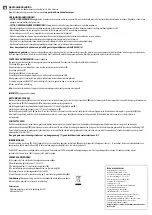
01/2001, CATTRON
- THEIMEG
TM
Cranesafety 5
6. THE HAND-HELD PORTABLE REMOTE CONTROLLER
, continued.
+
When an operator is putting on or taking off the controller by means of its belt loop
strap, carrying harness, or shoulder strap, the controller shall be switched OFF
beforehand, using the appropriate ON/OFF switch(es). When the controller is
equipped with a STOP button, it shall be set to the ‘STOP’ position before switching
off power to the controller.
+
The portable remote controller shall always be switched ‘OFF’ when not in use and,
when practical, stored under lock and key.
7. OPERATING THE REMOTE CONTROLLED CRANE.
+
All crane limit switches shall be checked at the beginning of each turn or when a new
operator takes control of the crane. While checking the limit switches, the hoist shall
be centered over an area free of personnel and equipment so that if the limit switches
fail, and the hook and block assembly falls, no one will be injured and no equipment
will be damaged.
+
The limit switches shall never be used as a regular stopping devices. They are
intended to be protective devices only.
+
The bridge and trolley brakes shall be tested at the beginning of each turn or when a
new operator takes control of the crane. They should be tested with the bridge and
trolley at low speed.
+
When lifting maximum or near maximum loads, the operator shall test the hoist
brakes by raising the load a few inches from the floor. If hoist brakes do not hold, the
load shall be immediately lowered to the floor and a report made to the supervisor.
+
Do not make lifts in excess of the rated capacity of the crane.
+
When making lifts, the bridge and trolley shall be centered directly over the load to
prevent load swinging when the load is raised.
+
Side pulls shall be made only with the permission of, and under direct supervision of
management. When such a lift is being made, operators shall not position themselves
in the line or path of travel of the load, but shall operate the crane from a position to
the side opposite to the path of travel.
+
When raising or lowering a load, proceed slowly and make certain the load is under
control. Tag lines shall be used for handling lengths or bulky loads. Take the slack
out of the chains or slings gradually. Make sure all personnel are clear before making
a lift.
+
PRC crane operators shall keep all parts of their bodies away from the load and never
position themselves under the load.
+
Do not make a lift or move the crane if anyone is in a position to be injured.
+
If a PRC crane operator is being helped, he or she shall not move the crane until he or
she receives an ‘all clear’ signal from the helper(s).
+
Loads shall not be carried over workers' heads.
Summary of Contents for i-Key
Page 2: ......
Page 14: ...Page xii 01 2001 CATTRON THEIMEG TM EZ CS AT Rx Rx Tx Tx Tx Rx Rx Rx ...
Page 20: ...Section 1 Page 6 01 2001 CATTRON THEIMEG TM This page intentionally left blank ...
Page 44: ...Section 4 Page 4 01 2001 CATTRON THEIMEG TM ...
Page 52: ...Section 4 Page 12 01 2001 CATTRON THEIMEG TM This page intentionally left blank ...
Page 68: ...Section 5 Page 16 01 2001 CATTRON THEIMEG TM This page intentionally left blank ...
Page 75: ... 01 2001 CATTRON THEIMEG TM Section 6 Page 7 Item 7 Carrying strap shoulder Part 42C 0057 ...
Page 89: ......

